Mysterious Descent Into Madness That Left No Trail--Only Tragedy
- Share via
HOUGHTON, Mich. — Tortured by schizophrenia, his mind a hellish whirl of bizarre images and voices, John Anthony Segreto may not have realized he was doomed.
But the police knew. Throughout a blizzard-swept night, they had struggled to coax the angry, visibly deranged Segreto into releasing a terrified young woman strapped to a homemade bomb in a car stalled in the snow.
The previous afternoon Segreto had barged into MFC-First National Bank in Houghton, a college town of 7,500 in Michigan’s far northwest. Brandishing a .20-gauge shotgun, he demanded money and a married woman to be held as a hostage.
It made no sense. The downtown bank was in the same block as the police station. Heavy snowfall whipped by gusts off nearby Lake Superior had brought traffic to a crawl, making a quick getaway impossible. Anyway, Segreto didn’t even have a car.
It quickly became apparent the 25-year-old man was mentally ill.
Coached by psychologists, police tried talking him out of the bank employee’s car where he had taken refuge with his hostage.
But about 6 a.m., with dawn approaching and snow drifting ever higher, the situation worsened.
Segreto sliced off some of hostage Tracy Immonen’s brown hair with a kitchen knife. Tossing the strands out the car window, he warned that if his demands weren’t met, her fingers would come next.
He demanded, among other things, to talk with President Clinton.
Houghton Police Chief Ralph Raffaelli, fearing that Segreto was reaching the breaking point, decided that the time for talk was over. He conferred with representatives of the FBI, the Michigan State Police, the county Sheriff’s Department.
“Our goal had been to get him out and get her to safety. That’s all anybody ever wanted,” Raffaelli later recalled.
It was not to be. The decision was made: John Segreto must die.
This is more than the story of a young man’s inexplicable crime and tragic end. That fateful January day followed a mysterious plunge into insanity that Segreto’s family felt powerless to comprehend, much less cure.
Their struggle may be painfully familiar to relatives of the 2.5 million Americans with some form of schizophrenia. Still, most schizophrenics are not violent. And those edging toward violence usually drop telltale hints.
“You do have a rare bird here,” says Richard Greer, a forensic psychiatrist with the University of Florida.
Segreto grew up in Southern California with his parents and sister, an “incredibly normal, suburban middle-class” childhood, says his uncle, Bill O’Donnell of Houghton.
There were family vacations to Hawaii, fishing in the mountains, a dog. He played baseball but wasn’t a jock, fancied computers but wasn’t a nerd. He took a date to the high school prom and spoke of having a wife, children, a house in the country.
“One of the hardest things we’re dealing with is the juxtaposition of who he was versus what he became at the end,” said O’Donnell, 47, an accountant and manager of a natural foods co-op.
“I fundamentally cannot imagine him even raising his voice before his illness. He was never violent in any way. He would never have been in a fight.”
Segreto enrolled at Michigan Technological University in Houghton, but drank too much and dropped out. After a couple of years back home, he returned to school in 1993.
About that time, relatives began to notice subtle changes in his personality: He became more critical, even suspicious. O’Donnell chalked it up to youthful rebelliousness.
By early 1994 Segreto stopped going to class, telling O’Donnell that he couldn’t trust his professors. He returned to California, then in May told his parents that he was bound for Alaska.
They next heard from him in September, when he stepped off a plane in the Canadian city of Vancouver, B.C. He had a backpack, a bicycle and a dog.
He had been in Switzerland.
He’d asked for asylum in Switzerland, saying the U.S. government was trying to kill him. Instead, he got a ticket out of the country. In Canada he repeated his request and was sent to a mental institution, where he was diagnosed a paranoid schizophrenic.
Released after a couple of months, Segreto went home to California. He stopped taking his medicine, and his mental illness raged.
“There were hardly any parts of the old John left,” O’Donnell says. He was “very withdrawn, very paranoid.”
O’Donnell visited his California relatives in Christmas 1994. He’d always been close to his nephew and hoped to get through to him.
“He would ask me if I remembered him being tortured,” O’Donnell says. “He talked about hearing voices, he talked about not liking his medication because it stopped him from being able to read people’s minds.”
He took off again the following spring, this time for the streets. He was mugged and robbed.
Last summer he returned to Houghton, where O’Donnell and his mother figured they could keep an eye on him and get him help. They notified local police agencies and the county mental health department.
Segreto lived with his grandmother, mostly holed up in his room, writing obsessively on a personal computer. He had decided to publish a book “about good and evil, about how to be a little nicer to the planet, how to raise your children better,” O’Donnell says.
He posted rambling commentaries on the Internet. Topics ranged from environmental protection and pet care to diatribes against the mental health system.
“People have/are torturing/persecuting/’trying to drive crazy’ me,” he wrote. “I have proof. I have them on tape/. . . . I would like a lawyer. I would like donations/gifts. (cash preferably).”
Occasionally he submitted writings to the Daily Mining Gazette of Houghton.
“We could never accept them. They were incoherent and much too long,” Managing Editor Cyndi Perkins said. “He was always very polite about it.”
Segreto seemed frustrated with the difficulty of spreading his message, O’Donnell says. But no one imagined that beneath his relatively calm exterior, rage and paranoia were building toward a violent explosion.
Unknown to his family, he managed to build a crude bomb. He bought a shotgun and sawed off the barrel.
Shortly before 3 p.m. Jan. 18, Laurie Raffaelli, branch manager of MFC-First National, put in a hurried call to the Police Department. She is the police chief’s sister-in-law, her husband, Jim Raffaelli, a police sergeant.
“I think the bank is being robbed,” she reported.
When Segreto demanded a married woman as hostage, Laurie Raffaelli stepped forward. He strapped the makeshift bomb to her. Suddenly he fired--whether he meant to isn’t clear--hitting Raffaelli in the side and left arm. She would recover but lose most of her arm.
Segreto then ordered bank teller Jill Ruohonen to fasten the bomb to another co-worker, 22-year-old Tracy Immonen. Given a bag of money, he marched the two women to a nearby parking deck. He released Ruohonen after commandeering her blue Dodge Spirit and ordering Immonen into the back seat.
Segreto began driving, but police shot out the car’s tires. It bogged down in foot-deep snow, almost directly across from the police station.
Thus began a 16-hour standoff, complicated by one of the worst blizzards on record in a town where harsh winters are a way of life. Segreto kept the engine running and the heat on.
Immonen, who declined to be interviewed about her ordeal, lay on the floor behind the front seat, covered with a blanket.
Police gave Segreto a burger and fries and a cellular telephone. He called the Daily Mining Gazette, saying he wanted “to give demonstrated proof of good and evil in this world.”
He rebuffed one negotiator after another for failing to meet his demands. O’Donnell and other family members kept a vigil at the police station, but Chief Raffaelli said Segreto wouldn’t see them.
“He wanted to talk to the president of the United States, the presidents of foreign countries,” Raffaelli said. “I told him, ‘John, you know I can’t get the president here.’
“But there was just no talking to him. Nobody could get through to him, nobody.”
Shortly after 7:35 a.m. the next morning, the blizzard is still raging. There’s only partial daylight, but four state police sharpshooters have a clear view inside the car from a building 25 yards away.
They’ve seen Segreto shifting a detonating device from hand to hand, occasionally setting it down. A good sign: It means the bomb won’t explode automatically if he isn’t holding the detonator.
He puts it down one last time.
The sharpshooters fire as one, the roar of their assault rifles all but lost in the howling wind. Four bullets slam into Segreto’s head.
He dies instantly.
Police carefully remove the bomb from Immonen. They later determine that it was a “grenade-type device” containing black powder. Had it gone off, Raffaelli says, Immonen would be dead.
Since that day, questions have haunted Segreto’s survivors: Why did it happen? Could it have been prevented?
In Michigan and most other states, mentally ill people can be involuntarily committed only if a court finds them dangerous to themselves or others, or unable to attend to their own basic needs.
O’Donnell says the family walked a fine line in the last months of Segreto’s life.
He bristles at the notion that they missed or ignored signs that Segreto was a ticking time bomb.
“You think that if I saw something I would have either allowed somebody else to be harmed or allowed my nephew to be harmed?” he asks.
“This is not a person who when he was 15 years old beat up the next-door neighbor, and when he was 17 years old had a fight with the high school principal and trashed his house. There was none of that.”
O’Donnell recalls that during his Christmas 1994 visit to California, he put the question directly to Segreto: Did he feel suicidal or violent?
“He said no, he couldn’t do that. How could he? He thought he was on a righteous path of life. . . . He was going to take better care of this planet.
“How could he be violent?”
More to Read
Sign up for Essential California
The most important California stories and recommendations in your inbox every morning.
You may occasionally receive promotional content from the Los Angeles Times.













